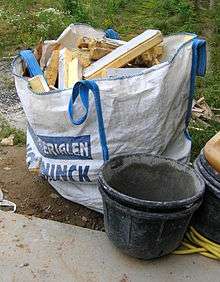Construction waste
Construction waste (a. k. a. construction and demolition materials, or C&D materials) consists of unwanted material produced directly or incidentally by the construction or industries.[1] This includes building materials such as insulation, nails, electrical wiring, shingle, and roofing as well as waste originating from site preparation such as dredging materials, tree stumps, and rubble. Construction waste may contain lead, asbestos, or other hazardous substances.[2]

Types of waste
Much building waste is made up of materials such as bricks, concrete and wood damaged or unused for various reasons during construction. Observational research has shown that this can be as high as 10 to 15% of the materials that go into a building, a much higher percentage than the 2.5-5% usually assumed by quantity surveyors and the construction industry. Since considerable variability exists between construction sites, there is much opportunity for reducing this waste.[3]
Recycling, disposal and environmental impact
Some certain components of construction waste such as plasterboard are hazardous once landfilled. Plasterboard is broken down in landfill conditions releasing hydrogen sulfide, a toxic gas.
It is possible to recycle many elements of construction waste. Often roll-off containers are used to transport the waste. Rubble can be crushed and reused in construction projects. Waste wood can also be recovered and recycled.
Where recycling is not an option, the disposal of construction waste and hazardous materials must be carried out according to legislation of relevant councils and regulatory bodies. The penalties for improper disposal of construction waste and hazardous waste, including asbestos, can reach into the tens of thousands of dollars for businesses and individuals.
In England, all personnel performing builders or construction waste clearance are required by law to be working for a CIS registered business.[4]
Landfilling
The traditional disposal way for construction waste is to send it to landfill sites. Sending the waste directly to a landfill causes many problems:
Climate impact of construction waste
Construction waste is a source of carbon dioxide emissions.
References
- "Glossary - Wastenot- Waste management in the South East". web.archive.org. 2007-03-10. Archived from the original on 2007-03-10. Retrieved 2020-02-21.
- "Safety Knowledge". www.nsc.org. Retrieved 16 April 2018.
- Skoyles ER. Skoyles JR. (1987) Waste Prevention on Site. Mitchell Publishing, London. ISBN 0-7134-5380-X
- "Construction Industry Scheme (CIS)". GOV.UK. Retrieved 2020-02-21.
- "RECYCLING CONSTRUCTION AND DEMOLITION WASTES A Guide for Architects and Contractors" (PDF). April 2005.
- "Construction Waste Management | WBDG Whole Building Design Guide". www.wbdg.org. Retrieved 2017-05-06.
External links
- Construction Waste Management Database from the Whole Building Design Guide of the National Institute of Building Sciences
- https://www.rmf-services.co.uk/recycled_raised_flooring/construction_waste_facts.aspx

